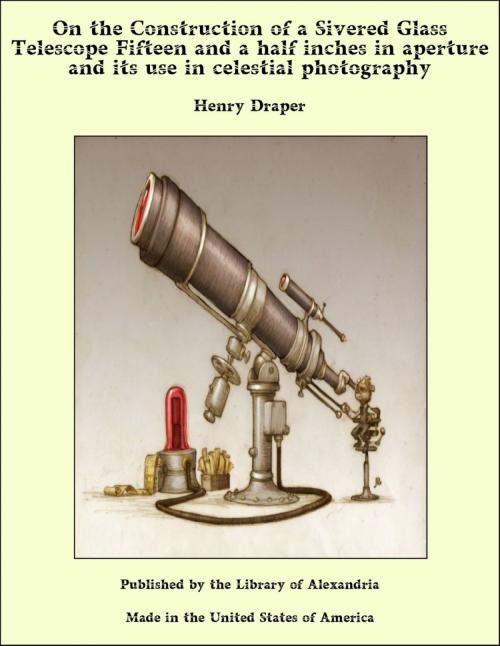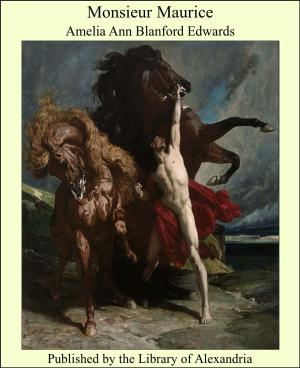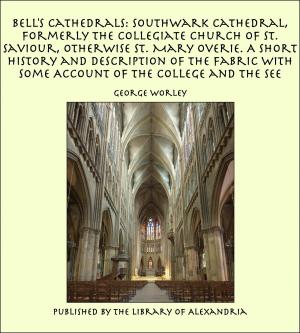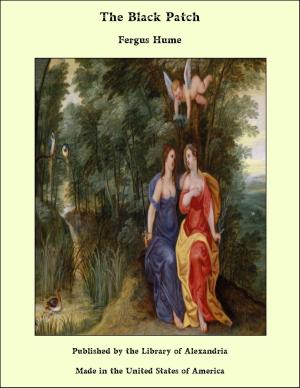On the Construction of a Sivered Glass Telescope Fifteen and a Half Inches in Aperture and its use in Celestial Photography
Nonfiction, Religion & Spirituality, New Age, History, Fiction & Literature| Author: | Henry Draper | ISBN: | 9781465620248 |
| Publisher: | Library of Alexandria | Publication: | March 8, 2015 |
| Imprint: | Language: | English |
| Author: | Henry Draper |
| ISBN: | 9781465620248 |
| Publisher: | Library of Alexandria |
| Publication: | March 8, 2015 |
| Imprint: | |
| Language: | English |
The construction of a reflecting telescope capable of showing every celestial object now known, is not a very difficult task. It demands principally perseverance and careful observation of minutiæ. The cost of materials is but trifling compared with the result obtained, and I can see no reason why silvered glass instruments should not come into general use among amateurs. The future hopes of Astronomy lie in the multitude of observers, and in the concentration of the action of many minds. If what is written here should aid in the advance of that noble study, I shall feel amply repaid for my labor. A short historical sketch of this telescope may not be uninteresting. In the summer of 1857, I visited Lord Rosse’s great reflector, at Parsonstown, and, in addition to an inspection of the machinery for grinding and polishing, had an opportunity of seeing several celestial objects through it. On returning home, in 1858, I determined to construct a similar, though smaller instrument; which, however, should be larger than any in America, and be especially adapted for photography. Accordingly, in September of that year, a 15 inch speculum was cast, and a machine to work it made. In 1860, the observatory was built, by the village carpenter, from my own designs, at my father’s country seat, and the telescope with its metal speculum mounted. This latter was, however, soon after abandoned, and silvered glass adopted. During 1861, the difficulties of grinding and polishing that are detailed in this account were met with, and the remedies for many of them ascertained. The experiments were conducted by the aid of three 151/2 inch disks of glass, together with a variety of smaller pieces. Three mirrors of the same focal length and aperture are almost essential, for it not infrequently happens that two in succession will be so similar, that a third is required for attempting an advance beyond them. One of these was made to acquire a parabolic figure, and bore a power of 1,000. The winter was devoted to perfecting the art of silvering, and to the study of special photographic processes. A large portion of 1862 was spent with a regiment in a campaign in Virginia, and but few photographs were produced till autumn, when sand clocks and clepsydras of several kinds having been made, the driving mechanism attained great excellence. During the winter, the art of local corrections was acquired, and two 151/2 inch mirrors, as well as two of 9 inches for the photographic enlarging apparatus, were completed. The greater part of 1863 has been occupied by lunar and planetary photography, and the enlargement of the small negatives obtained at the focus of the great reflector. Lunar negatives have been produced which have been magnified to 3 feet in diameter. I have also finished two mirrors 151/2 inches in aperture, suitable for a Herschelian telescope, that is, which can only converge oblique pencils to a focus free from aberration. This work has all been accomplished in the intervals of professional labor.
The construction of a reflecting telescope capable of showing every celestial object now known, is not a very difficult task. It demands principally perseverance and careful observation of minutiæ. The cost of materials is but trifling compared with the result obtained, and I can see no reason why silvered glass instruments should not come into general use among amateurs. The future hopes of Astronomy lie in the multitude of observers, and in the concentration of the action of many minds. If what is written here should aid in the advance of that noble study, I shall feel amply repaid for my labor. A short historical sketch of this telescope may not be uninteresting. In the summer of 1857, I visited Lord Rosse’s great reflector, at Parsonstown, and, in addition to an inspection of the machinery for grinding and polishing, had an opportunity of seeing several celestial objects through it. On returning home, in 1858, I determined to construct a similar, though smaller instrument; which, however, should be larger than any in America, and be especially adapted for photography. Accordingly, in September of that year, a 15 inch speculum was cast, and a machine to work it made. In 1860, the observatory was built, by the village carpenter, from my own designs, at my father’s country seat, and the telescope with its metal speculum mounted. This latter was, however, soon after abandoned, and silvered glass adopted. During 1861, the difficulties of grinding and polishing that are detailed in this account were met with, and the remedies for many of them ascertained. The experiments were conducted by the aid of three 151/2 inch disks of glass, together with a variety of smaller pieces. Three mirrors of the same focal length and aperture are almost essential, for it not infrequently happens that two in succession will be so similar, that a third is required for attempting an advance beyond them. One of these was made to acquire a parabolic figure, and bore a power of 1,000. The winter was devoted to perfecting the art of silvering, and to the study of special photographic processes. A large portion of 1862 was spent with a regiment in a campaign in Virginia, and but few photographs were produced till autumn, when sand clocks and clepsydras of several kinds having been made, the driving mechanism attained great excellence. During the winter, the art of local corrections was acquired, and two 151/2 inch mirrors, as well as two of 9 inches for the photographic enlarging apparatus, were completed. The greater part of 1863 has been occupied by lunar and planetary photography, and the enlargement of the small negatives obtained at the focus of the great reflector. Lunar negatives have been produced which have been magnified to 3 feet in diameter. I have also finished two mirrors 151/2 inches in aperture, suitable for a Herschelian telescope, that is, which can only converge oblique pencils to a focus free from aberration. This work has all been accomplished in the intervals of professional labor.















